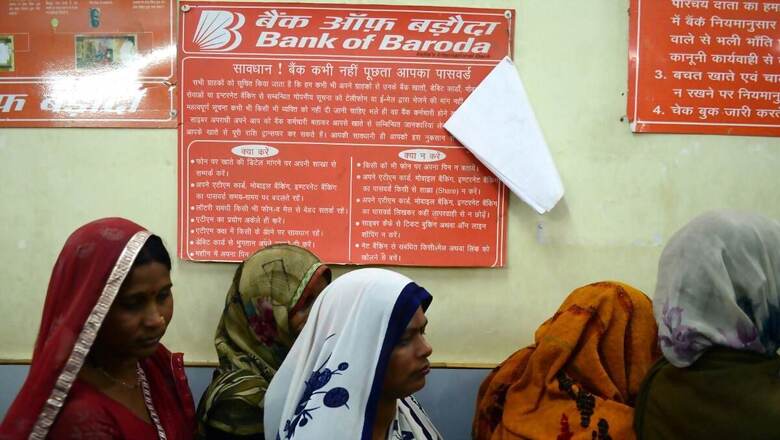
views
The Pradhan Mantri Jan-Dhan Yojana (PMJDY), now the world’s largest financial inclusion scheme, was launched on August 28, 2014, with the aim of ‘Banking the Unbanked’, resulting in 179 million accounts being opened in the first year alone. The PMJDY’s objective has been to ensure access to various financial services, such as basic savings bank accounts, need-based credit, remittance facilities, insurance, micro-credit, and pensions for excluded sections, namely weaker sections and low-income groups. PMJDY accounts recently crossed the 530 million mark, with over 53 crore accounts opened in the past ten years, and deposits exceeding a substantial Rs 2.31 lakh crore.
Operative accounts as a percentage of total accounts stand at a healthy 81 per cent. Average deposits rose to Rs 4,076 in August 2023, up from Rs 3,398 in 2021. The average deposit per account has increased significantly from Rs 1,279 in August 2015, indicating greater usage of accounts. PMJDY has expanded its coverage to over 67 per cent of rural and semi-urban areas and boasts over 56 per cent of women account holders, exemplifying a remarkable achievement in gender parity. Over 55 million PMJDY account holders receive direct benefit transfers (DBT) from the Modi government. Fewer than 8 per cent of the accounts have a zero balance.
Public sector banks are the key drivers of the scheme, holding over Rs 1.8 lakh crore in deposits, followed by Regional Rural Banks (RRBs) and private sector banks, which hold the remaining deposits. The digital revolution under the Modi government and financial inclusion via PMJDY have been feeding off each other seamlessly.
The Modi government has further boosted PMJDY by extending the benefits of its flagship insurance schemes, PM Jeevan Jyoti Bima Yojana (PMJJBY) and PM Suraksha Bima Yojana (PMSBY), to PMJDY account holders. This has improved these account holders’ access to micro-credit and micro-investment plans, such as flexi-recurring deposits.
PMJDY is a national mission for financial inclusion. Beneficiaries receive a RuPay Debit card with in-built accident insurance cover of Rs 2 lakh for accounts opened after August 2018 and Rs 1 lakh cover for those opened prior to that period. Technological issues, such as poor connectivity and glitches in online transactions, have been effectively addressed in mobile transactions over the last ten years. In fact, technology has been aptly utilised as a significant enabler, something that was not meaningfully achieved before 2014 under the successively incompetent Congress regimes. The Modi government is indeed making strong strides towards globalising this indigenous payment method.
Speaking of RuPay, RuPay credit card spending crossed Rs 10,000 crore in a month for the first time in December 2023, driven by robust growth in credit card transactions through the Unified Payments Interface (UPI). It is noteworthy that the Reserve Bank of India only allowed RuPay credit cards to be linked to UPI as recently as mid-2022. Even at a monthly Rs 10,000 crore, RuPay’s market share in credit card spending is over 6 per cent of the total credit card spending in India, which is great news. Overall, credit card spending in the country was approximately Rs 1.65 lakh crore in December 2023. The UPI platform, which enables instant fund transfers between bank accounts, processes between 12-14 billion transactions valued at Rs 17 lakh crore in a month. Needless to say, PMJDY, UPI, and RuPay are spearheading the digital revolution in India, thanks to PM Modi’s economic vision and foresight.
In another milestone, the number of RuPay credit cards in circulation crossed 10 million in December 2023, representing slightly more than 10 per cent of the overall credit cards in circulation. Public sector firm SBI Cards has also accelerated the issuance of RuPay credit cards. This has helped lift RuPay’s market share in new credit card issuances to over 25 per cent in mid-2023, up from 10 per cent in 2022. There are over 70 million merchants using the UPI platform, while the number of point-of-sale (POS) terminals exceeds 8.5 million. The popularity of UPI and the ability to link credit cards to UPI have made the RuPay platform more attractive. Of the approximately 100 million credit card customers in India, only 40 million are unique, making RuPay especially appealing to customers who own more than one credit card. Former PM Rajiv Gandhi noted that, in India in the 1980s, out of 100 paise of benefits, only 15 paise reached the true beneficiary. The remaining 85 paise were gobbled up by middlemen and sarkaari babus. Thanks to PM Modi’s Digital India, 100 per cent of all benefits now reach the beneficiary through DBT.
Coming back to Jan Dhan, more than 1.5 lakh ‘Bank Mitras’ became part of PMJDY to ensure it reached the remotest and poorest parts of India. Under the PM Garib Kalyan Yojana (PMGKY), a sum of over Rs 30,945 crore was credited into the accounts of women PMJDY account holders during the COVID-19 lockdown. In fact, thanks to the JAM trinity, with Jan Dhan accounts at the forefront, the adverse impact of COVID-19 was significantly minimised in India, particularly in terms of financial access.
‘Banking the Unbanked’ refers to the opening of basic savings bank deposit (BSBD) accounts with minimal paperwork, relaxed KYC, e-KYC, account opening in camp mode, zero balance, and zero charges. ‘Securing the Unsecured’ pertains to the issuance of indigenous debit cards for cash withdrawals and payments at merchant locations. ‘Funding the Unfunded’ relates to other financial products such as micro-insurance, overdraft for consumption, micro-pension, and micro-credit. Jan Dhan accounts are online accounts within the core banking system, replacing the earlier method of offline accounts. Interoperability through the RuPay debit card or Aadhaar-enabled Payment System (AePS) has been a significant force multiplier.
The Modi government decided to extend the comprehensive PMJDY programme beyond 2018, with some modifications. The focus shifted from ‘Every Household’ to ‘Every Unbanked Adult’. The free accidental insurance coverage on RuPay cards increased from Rs 1 lakh to Rs 2 lakh for PMJDY accounts opened after 28 August 2018. The scheme also provides Rs 2 lakh for accidental death and full disability, and Rs 1 lakh for partial disability, for a premium of just Rs 12 per annum. Enhancements in overdraft (OD) facilities were introduced, with the OD limit doubling from Rs 5,000 to Rs 10,000, and with OD up to Rs 2,000 given without conditions. The upper age limit for OD was also raised from 60 to 65 years.
PMJDY has been the foundation stone for people-centric economic initiatives. Whether it is direct benefit transfers, COVID-19-related financial assistance, PM-KISAN, increased wages under MGNREGA, or life and health insurance cover, the first step of all these initiatives is to provide every adult with a bank account, which PMJDY has been doing on a war footing. One in two bank accounts opened between March 2014 and March 2022 was a PMJDY account. Within 10 days of the nationwide lockdown, more than 20 crore women PMJDY accounts were credited with ex-gratia payments. PMJDY provides an avenue for the poor to bring their savings into the formal financial system, remit money to their families in villages, and escape the clutches of infamous, usurious moneylenders. PMJDY has brought the unbanked into the banking system, expanded India’s financial architecture, and brought financial inclusion to almost every adult.
The Modi government is further strengthening the PMJDY by extending facilities for micro-insurance, including life and accident cover for all account holders under the scheme. It is working out a roadmap for greater financial inclusion, which will focus on doorstep banking, digital financial products, and convergence with its flagship pension and insurance schemes.
Financial inclusion is a national priority of the Modi government, as it is an enabler for holistic growth. The journey of PMJDY-led interventions undertaken over a short span of 10 years has, in effect, produced both transformational and directional change, thereby making the emerging financial ecosystem capable of delivering financial services to the most marginalised individuals and the poorest of the poor. The underlying pillars of PMJDY—namely, ‘Banking the Unbanked’, ‘Securing the Unsecured’, and ‘Funding the Unfunded’—have enabled the adoption of a multi-stakeholder collaborative approach, while leveraging technology to serve both unserved and underserved areas.
PM Modi has repeatedly underscored that India’s Digital Public Infrastructure offers scalable, secure, and inclusive solutions for global challenges, with its rich diversity making it an ideal testing ground. The PM welcomed the creation of a G20 virtual Global Digital Public Infrastructure Repository and highlighted the importance of a common framework for digital public infrastructure. In effect, India’s significant digital progress and its potential to serve as a testing ground for innovative solutions with global applicability have been hallmarks of PM Modi’s tenure.
In recent years, the Modi government has removed 1.86 crore fake farmers, 2.5 lakh fake companies, 4.2 crore fake ration cards, 2 crore fake MNREGA cards, 4.11 crore fake LPG connections, and 28 lakh fake madrasa students. This has resulted in cumulative savings of over Rs 2.73 lakh crore for the nation, achieved through the effective use of technology, which has bridged the erstwhile digital divide and given financial inclusion schemes like PMJDY a whole new dimension—something that is at the heart of Modinomics. Under Prime Minister Narendra Modi, the scale and pace of India’s digital transformation have been groundbreaking, with India’s 850 million internet users benefiting from the world’s most affordable data costs.
The use of technology to enhance governance, such as Aadhaar—a unique digital identity platform that covers over 1.3 billion people—and the transformative JAM trinity, which has revolutionised financial inclusion, exemplifies this progress. India’s UPI payment system facilitates over 46 per cent of global real-time payments. Thanks to PM Modi’s tireless vision, direct benefit transfer (DBT)—which has saved over $33 billion by plugging system leakages—and the CoWIN portal, which became a crucial tool during India’s extensive COVID-19 vaccination campaign, have been pivotal.
No government in post-independent India has embraced welfarism within the larger framework of a capitalist order as seamlessly as the Modi government, and that speaks volumes about PM Narendra Modi’s commitment to a socio-economic order that encourages egalitarianism, free markets, and competition.
Sanju Verma is an Economist, National Spokesperson of the BJP and the Bestselling Author of ‘The Modi Gambit’. Views expressed in the above piece are personal and solely those of the author. They do not necessarily reflect News18’s views.




















Comments
0 comment